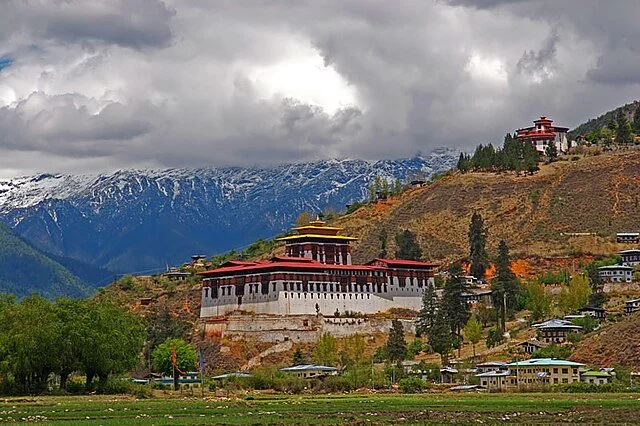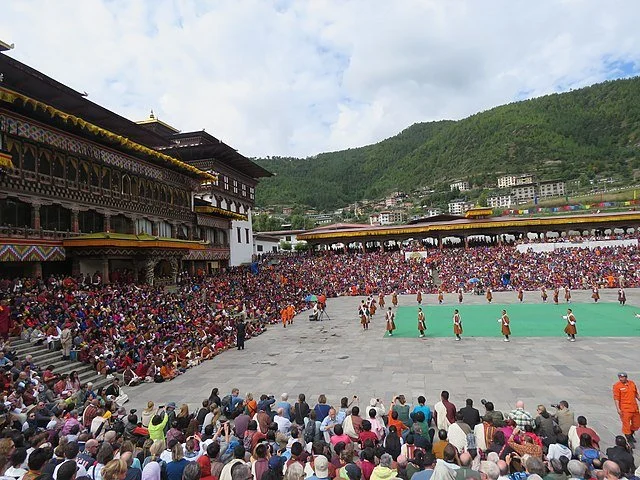With stunning architecture, beautiful natural vistas and a culture unlike anything else in the world, Bhutan truly is a once-in-a-lifetime destination.
Paro Dzong, the center of authority in the Paro valley. Jean-Marie Hullot, CC BY-SA 2.0
The Kingdom of Bhutan is one of the most unique places on Earth—between its position high in the Himalayas and the fact that it remained almost entirely isolated from the world until 1974, there is nowhere else quite like it.
Bhutan is a majority-Buddhist country situated between India and China, with much of its architecture constructed on the narrow slopes of the Himalayas. Until the 1970s, Bhutan did not allow any tourism into its territory, and television was only introduced in 1999 for fear that it would undermine the culture and government of the small nation. But perhaps the most unique aspect of Bhutan is the way in which the government measures the wellbeing of its citizens and determines most—if not all—domestic policies.
Gross National Happiness (GNH) is the metric by which the Bhutanese government measures the wellbeing and happiness of its people. This measurement is exclusively used in Bhutan, and it replaces the more common Gross Domestic Product system used by most countries. Instead of focusing on economic success and monetary value, Bhutan chooses to determine its path forward by measuring the collective happiness of its people.
This has led to Bhutan becoming something of a paradise for tourists; the entire nation gives off an aura of calm and tranquility, perfectly complementing the Buddhist foundations of its culture. These roots can be seen in almost every city and town within the mountainous nation, with several ancient temples open to tours.
The most famous of these is the Tiger’s Nest Monastery (Paro Taktsang), which was constructed in 1692 and still acts as a monastery today. Situated over 2 miles above the Paro valley and perched right on the edge of a massive cliff, the monastery was built into a cave system set into the rock face itself. Tiger’s Nest is only accessible through a three to four mile hike up a steep mountain—mules can be hired at the base, but can only take visitors up so far, as the slope actually becomes too steep for them to continue. At the top, however, the monastery provides one of the most beautiful views and an incredible example of Buddhist design.
Paro Taktsang, the Tiger’s Nest Monastery. Bernard Gagnon, CC BY-SA 4.0
In addition to its beautiful architecture, Bhutan also boasts a unique religious and dance culture. The best way to experience this is through one of its many festivals (or “tshechus”). The most famous and celebrated festival in all of Bhutan is Thimphu Tshechu, a three-day-long event that begins in October and is a showcase of Bhutanese music, art and cuisine. The main component is a series of ritual dances performed by elaborately-costumed monks, who act out stories from Buddhist mythology.
Thimphu Tshechu in 2019. Vinayaraj, CC BY-SA 4.0
A similar festival, Paro Tshechu, is held in March to celebrate Guru Rinpoche, who brought Buddhism to the Himalayas centuries ago. The high point of this festival is the unfurling of a massive tapestry of the Guru, called a Thongdrol, at dawn on the final day of celebration. According to tradition, the tapestry must be quickly rolled up again before the first sunlight of the morning hits it. Both of these festivals are fully open to tourists, and have become extremely popular over the years that the nation has been open to visitors.
Bhutan truly must be seen to be believed. It is a one-of-a-kind society, a gem of Buddhist history nestled in the Himalayan mountains that has remained untouched by the outside world longer than almost any other nation on Earth. No matter when or where you go, you’ll be immersed in a wholly unique culture, with gorgeous architecture, incredible views and a powerfully individual perspective on what happiness is all about.
Bhutan requires all international tourists to pay a fee of $100 per day (lowered from $200 until September of 2027), although children between six and 12 are charged $50 per day and those younger than six do not need to pay. This price covers the visa that Bhutan requires for visitation, and is often included in hotel and transportation costs. The two largest cities, Thimphu and Paro, have a variety of hotels listed Google Hotels, which average around $54 and $32 in price, respectively. The nation has only one international airport, located in Paro.
Ryan Livingston
Ryan is a senior at The College of New Jersey, majoring in English and minoring in marketing. Since a young age, Ryan has been passionate about human rights and environmental action and uses his writing to educate wherever he can. He hopes to pursue a career in professional writing and spread his message even further.




